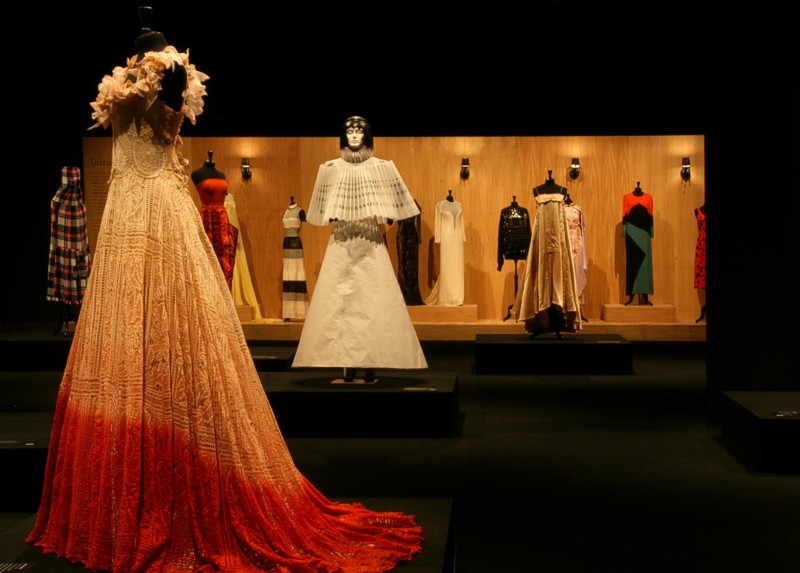Fashion in Brazil: Contemporary and Past (Moda no Brasil: criadores contemporâneos e memória)
The exhibition is divided into ten clusters comprising a stroll through the history of Brazilian fashion. Contemporary Creators, consists of twenty looks seen as edge creativity projects by designers showing at the exhibition. Based on their national and international projection, production developed in Brazil, and commercial visibility over the last 10 years, the following designers were selected to show their items: Alexandre Herchcovitch, André Lima, Carlos Miele, Clô Orozco, Dudu Bertholini e Rita Camparato (Neon), Fause Haten, Gloria Coelho, Isabela Capeto, Jefferson Kulig, Jum Nakao, Karlla Girotto, Lenny Niemeyer, Lino Villaventura, Lorenzo Merlino, Marcelo Sommer, Martha Medeiros, Reinaldo Lourenço, Ronaldo Fraga, Samuel Cirnansck, and Walter Rodrigues.
Pau-Brasil, the second cluster, provides an introduction to Brazil’s relationship with bodily ornamentation. It includes works by the artist Maria Lúcia Barbosa that revisit indigenous materials and techniques together with contemporary jewelry.
Also displayed are publications, magazines, supplements and leaflets with fashion illustrations. In the 19th century and for much of the 20th too, these sketches were the only means for information on this subject to reach people. Their original titles follow with free translations in brackets: O Jardim das Damas [Ladies’ Garden] from Portugal and numerous Brazilian publications such as Espelho Diamantino, Manequim, O Cruzeiro, Jornal das Damas and A Cigarra [Diamond Mirror, Mannequin, Cruiser, Ladies Journal and Cicada].
The Trade and Industry block shows two important sectors for the story of fashion in Brazil: the textile industry and trade, which have had a strong presence in Brazil since the 19th century. Examples: Matarazzo, Alpargatas, Santistas, and a large number of shops and clothing stores ranging from street stores, boutiques, and department stores to shopping malls.
Also to be appreciated at the museum are fabrics and advertisements taken from publications, a 1970s dress from Madame Rosita and a 1960s Vogue jumpsuit.
Fairs and Parades brings together photos from parades, publications, supplements, catalogs, invitations, among others, for events such as textile industry fairs (Fenit, Nacional de Tecelagem, Moda-Rio and others); parades (Mappin, Cruzeiros Moda, Janeiro Fashion Show, Phytoervas, Morumbi Fashion, SPFW etc.); groups of designers (Grupo Moda-Rio, Núcleo Moda-São Paulo, among others); Textile and Fashion Workers Association (ATESP, Aambra, Abemoda etc..).
The cluster is also displaying a dress designed by Rhodia, a center for fashion design studies created in the 1980s by the French company of the same name.
The Dressmakers cluster focuses on the industry’s anonymous satellites in the 19th century. Visitors may view dresses, mannequins, iron, sewing machine, and sewing caskets containing kit, manuals and publications.
Between the 1950s and 1980s, Brazil’s emerging fashion designers were initially exclusively selling made-to-measure clothing. Known as dressmakers or seamstresses, they became this segment’s first celebrities. This cluster includes Clodovil Hernandes, Guilherme Guimarães, Dener, José Gayegos, José Nunes, Markito, Ronaldo Esper, Rui Spohr and Zuzu Angel.
The Industry Trainingspace revisits some of the early courses and methods for teaching sewing and dressmaking before the end of the 20th century, when university and colleges fashion courses were introduced. Shots taken in classrooms and exhibitions held at FAAP, such as Papiers à la Mode, in 2008, are part of this cluster too.
The Very Latest block showcases the new generation of designers, some still in progress and other recently graduated, to reveal their style and beauty. This group includes Adriana Tristan from FAAP, the winner of the FAAP Fashion competition and New Designers Creative Award; Ana Paula Soares from SENAC; Augusto Ribeiro and Claudiana Cardoso from FMU; Elisa Quinteros from Santa Marcelina; Kledir Salgado from USP; Mariana Simoni and Thais Storino from Anhembi Morumbi – and Mauricio Somenzari, FAAP, also a FAAP Fashion winner.
The Face of Brazil , cluster highlights Brazilian products and their international impact. Models show jeans and bikinis from Brazil’s top brands. There are 50 pairs of flip-flops – known here as “legitimate Hawaiians” – to celebrate the brand’s 50th anniversary.
Due to the large and varied volume of information around this theme, the exhibition is conceptually based on a museological approach that is quite different from the usual chronological and linear approach.
Image courtesy of Museu de Arte Brasileira (MAB-FAAP), São Paulo, Brazil
